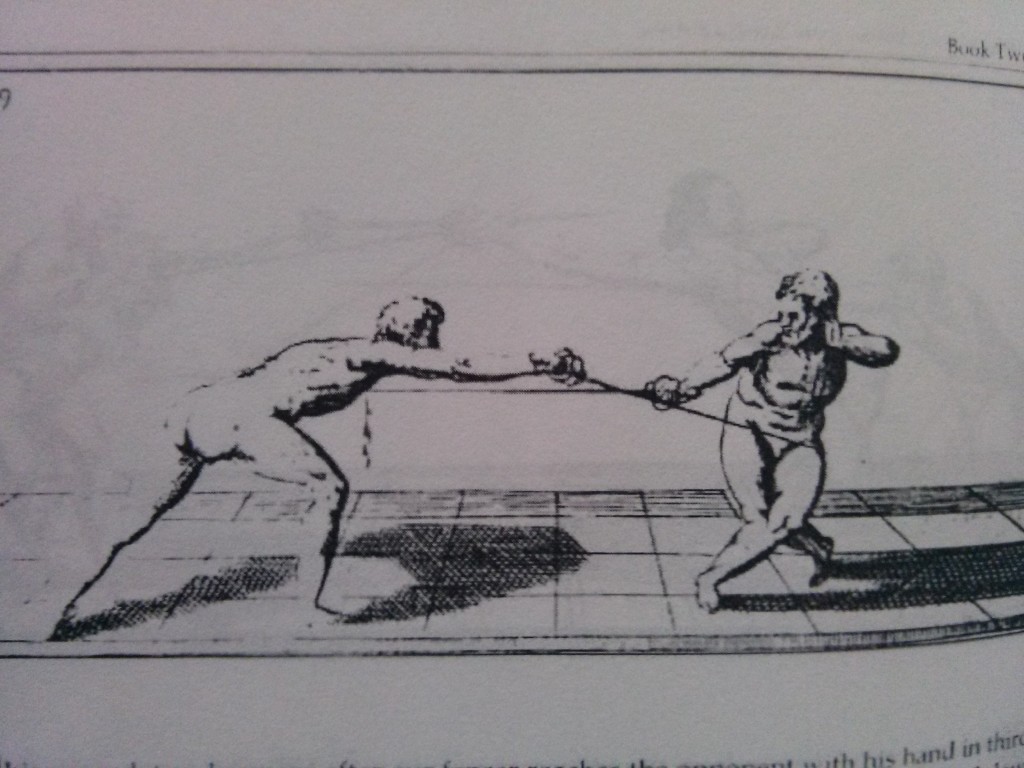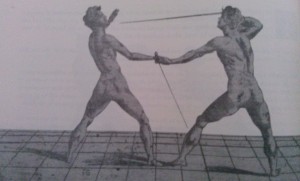Moving on from theory and swordplay it’s worth taking a moment to discuss the footwork Giganti employs beyond the lunge. He barely addresses advances as most fencers understand them (step the front foot forward, bring the back foot up to end in guard), and they may or may not exist in his system at all – only showing up as some variant on “advance to measure.” In contrast, Giganti goes into great detail with passes. Second to lunges, a passing step covers more distance than other any action. It takes longer than the lunge, which is why it is not preferable in general but can be useful in certain situations. There are two different types of passing step, though the types are not distinguished well within most manuals, and it is the situation that dictates which should be used.
From guard or from the completion of a lunge, passing begins with gravity. By letting the front knee buckle (stop resisting the weight bearing down on it), the fencer begins falling towards the front foot. Bringing the rear foot ahead of the front catches the fencer’s weight and redirects the momentum horizontally forward. Whether the hips rotate in this action or not dictates which of the two types of passing steps occurs.
The first type is usually just referred to as a “pass”. This is a single step, ending with the rear foot ahead of the sword foot, and including the rotation of the hips to turn the body from facing to the inside to facing to the outside. These are best used when passing to the outside. The rotation of the whole body keeps the line firmly closed by moving the body “behind” the sword (from the perspective of the enemy’s blade and his lines of attack) and brings your off-hand close to your opponent’s blade to either block a disengage or, if in range, seize their ricasso or guard and immobilize their weapon completely.

Outside pass to seize the guard

You can also half-sword during the outside pass to drive through any sort of resistance from your opponent. I highly recommend it when you need a pick-me-up.
The other type is, unfortunately, usually also called a “pass.” My habit is to call this a “full pass”. Earlier Italians called this a trapassata (“passing through”). These passes end with the sword foot forward, and include no rotation of the hips or body. This is really two steps: The rear foot is brought ahead of the sword foot, but still pointing slightly to the inside rear, so that the upper body is not forced out of alignment, and the sword foot is brought forward to return to the guard position.
Just as the pass is useful to the outside, this is more useful to the inside, as it keeps the rear shoulder back away from any attack on the inside line (rotating the hips here would cause a moment of squared-ness, opening the centerline to your opponent).
When in guard with the weight on the rear foot, retreats are achieved by kicking the rear foot back a few inches and falling on to it. This has limited distance. A backward trapassata can achieve a larger retreat, and, in general, trapassata control measure more smoothly.
Fabris also mentions “proceeding with natural steps,” simply walking forward – which is, after all, just falling forward and catching yourself repeatedly. This is inherently squared up, which Fabris counters with his deep forward bend to obscure target area.
Passing steps also facilitate some excellent disarms:
From the outside against a sword held in quarta, the sword can simply be removed from the hand by pulling the pommel toward you. A hand held in terza or seconda from the outside can be levered back over your opponent’s sword shoulder, unbalancing them backward (not exactly a disarm, but a useful teaching aid against charging bulls). It can also be rotated, palm up, over your own sword shoulder into an armbar.
When passing on the inside, you can seize the opponent’s hand in seconda, twist it into quarta, and remove the sword by pulling on the pommel. If their hand is already in quarta you can skip the twisting step. Also, seizing the guard in any position and pulling toward you will pull them off-balance toward you, or pull the sword from their grip.
Of course, these risk breaking fingers or other bones, and should only be performed against somebody you don’t like very much or who owes you money.


Pingback: Dante di Pietro